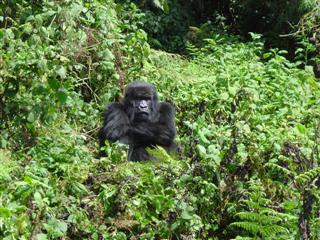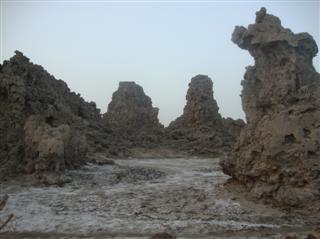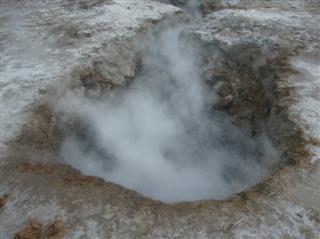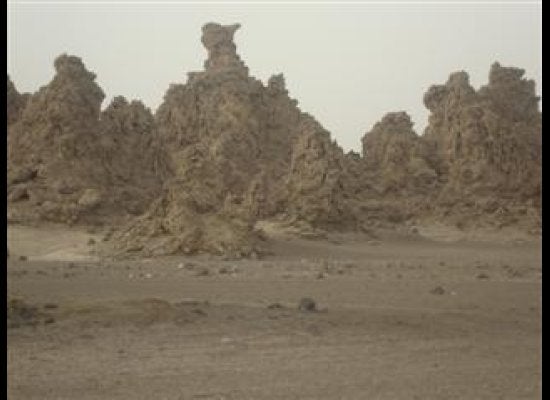The next time you drop into Djibouti on the Horn of Africa -- as I'm sure you all intend to -- exit the airport, rent a 4X4 and keep going about 120 miles southwest across one of the harshest and hottest spots on Earth. You'll eventually come to Planet of the Apes, the stark and remote reputed location for one of films in the cult series.
About half way along, your driver will probably stop at the market in the railway town of Ali Sabieh, load up with bundles of qat, the mild euphoria-causing narcotic that is the rage in the region, and spend the rest of the afternoon driving and chewing. Appearing more zonked by the minute, the bulge in his cheek will swell bolder and rounder as he stuffs more leaves into his mouth, and the green juice will dribble over his teeth and stain his lips.
By the time you've given up worrying whether he'll crash into the rare vehicle passing in the opposite direction along the multiple stoney tracks or into the long camel train of smugglers wending its way across the boulder-strewn plain from Ethiopia, you're almost there.
The harsh unforgiving terrain
Groves of grayish brown thorn trees, the same color as the stark stoney ground, stretch out towards grey-brownish crags and mountains -- the moon with a few trees. It's an ocean of rocks and stones. A small patch of solitary green on the cusp of a low cliff -- the same color as the driver's mouth which, inch for inch, has much more of it (showing there must be water somewhere).
Suddenly, a phantasmagorical scene of massive volcanic chimneys surges up on the distant horizon, tortured, twisted, cork-screwing and pinnacled like an ogre's vast castle. Tufts of green appear, ponds of water, calcified white chalk patches. You've arrived at Lac Abbé, desolate, unforgiving -- a filming location for Planet of the Apes, as proudly proclaimed by Lonely Planet, numerous blogs and Djiboutians themselves.
Volcanic 'chimneys' from afar
Up close Abbé's chimneys are even more fantastic -- scenes to illustrate a Grimm's fairy tales. There must be scores and scores of them soaring up from multiple bases, up to 150 feet high, the largest standing in solitary majesty. Boiling water bubbles up from the ground into pools or spurts geyser-like into the air. The chemical-laden lake stretches on into the mountains of Ethiopia, a sheet of sultry, inhospitable grey.
At twilight the chimneys take on even more bewitching forms. One is a seated lion, another a wolf baying at the moon, a third a huge French poodle begging. At dawn the vision of contorted pillars slowly emerging from the gloom to take on the full scope of their tormented shapes adds to the phantasmagoria.
Getting closer
There's even a camp -- rudimentary hut lodgings -- to pass the night. If you find it too stifling inside, put your cot under the big sky and a mosquito net. The brilliant stars will make pretty patterns through the netting. If you still find it impossibly hot, seek refuge, as my driver did despite his continuous supposedly euphoria-begetting qat chewing, in the air-conditioned 4X4.
Inside the ogre's castle
After all that, when you get back home, contact 20th Century Fox, the production company for Planet of the Apes, to find out just what part was filmed at Lac Abbé, and be told, despite all that Lonely Planet and the others say: 'None of the locations for any of the Planet of the Apes pictures were very far from right here near 20th Century Fox. While I'm certain the Abbé Lac area of Djibouti has a beautiful, otherworldly look to it, the Planet of the Apes is right here in the Southwest United States. Please feel free to verify by checking www.imdb.com (Internet Movie Database). I'm sorry to disappoint you.'
Unwilling to take the negation of my simian trip lying down, I do indeed check IMDb for locations: 20th Century Fox Ranch, Malibu Creek State Park, California; Glen Canyon and Lake Powell, Utah; Page, Arizona; Stage 20, 20th Century Fox Studios, 10201 Pico Blvd., Century City, Los Angeles; even Hyperion Sewage Treatment Plant, Playa Del Rey, California; even nearby sand dunes first filmed for Rudolph Valentino's The Sheik in 1921. But not a mention of Lac Abbé.
Steaming pool
Hmmmm! I never intended to be a myth-buster, but I'm not disappointed, however sorry Fox is. The trip is too interesting for that, the landscape, yes, too otherwordly, far too awesome in the word's original sense before its current one-stop usage.
So don't expect to see Roddy Macdowall prowling round Lac Abbé's chimneys as a simian Cornelius, Caesar or Galen -- or any of our currently extant, less anthropomorphic apes doing likewise, either. This is one piece of real estate that is not prime for apes. In fact humankind's closest relatives shirk aridity and starkness, opting instead for Garden of Eden-like green lushness.
About 1,000 miles to the west of Lac Abbé in Uganda chimpanzees, often considered our very closest cousins due to DNA similarity, roam the luxuriant trees of Kibale Forest National Park, not far from the verdant snow-capped Rwenzori mountains, also called the Mountains of the Moon though they are nothing like Abbé and its harsh moonscape.
Close to the home of chimpanzees and mountain gorillas in Uganda and Rwanda
A few score miles to the south in Rwanda, mountain gorillas take their leisurely time pasturing in a mist-shrouded emerald volcanic paradise that extends from Uganda into the Democratic Republic of Congo (DRC). On the other side of the continent, massive lowland gorillas, chimpanzees and sex-obsessed bonobos exult in the exuberant vegetation of lush forests - that is until lumber companies chop them down.
Mountain gorilla in her lush surroundings - Rwanda
Across the oceans in far-off Asia, that continent's only extant apes, the orangutan, swing and walk in their last remaining parcels of Eden in Sumatra and Borneo, threatened as they are by agriculture and timber felling.
Rehabilitated Borneo alpha male orangutan in natural habitat - Tanjung Puting, Indonesia
So if and when our closest animal relatives master human speech, if and when they read Lonely Planet and the blogs and see that Lac Abbé is claimed as their movie home, they're going to say: What on Earth are you talking about?
For more travel experiences see www.looneyfront.blogspot.com
Also by the same author, Shakespearean spoofs on modern politics at www.shakespeareredux.blogspot.com






